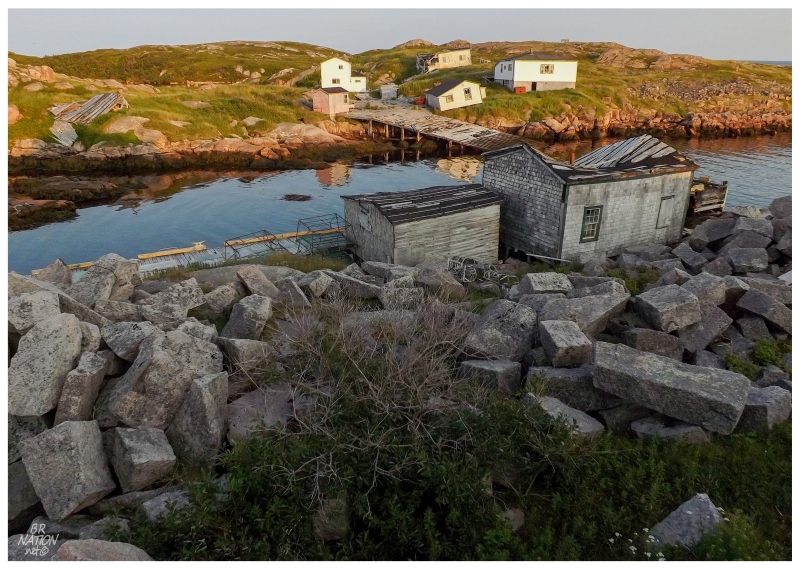One of my favourite recent developments was how our 2012 Grey Islands group trip led to the 2013 resettled village trip, which was hopefully going to lead to a 2014 group trip. In addition to the joy of going somewhere with close friends, there was also the force of our collective resources & the possibilities of where we could go with them. Initially we set our sights on St. Pierre et Miquelon. I really wanted my friends to go there if they weren't going to go any other way, but unfortunately, the logistics of getting six people to drive 8 hours each way & pay for an expensive ferry? The St. Pierre plans fell through within a month or two of planning. The effort, wear and exhausted time from failing at getting everyone to St. Pierre almost killed 2014's trip. There were consolation thoughts of simply going back to the Grey Islands, or even settling for something easy like a provincial ferry or this abandoned provincial park which we had been visiting lately. |

Thankfully I proposed going back to the resettled village I had visited in 2011, which is relatively close to Corner Brook & reached by a reliable boat ride. Of the six of us, I was the only one who had been there. Now of course I would have liked to go somewhere new, but this was more than a satisfactory consolation. I love accompanying people to go see remarkable places & I was sure that my friends would find the village to be a special and memorable place. Packing and planning for our multi-day trip, we tried to trim down what we were bringing, but when I had a hockey bag with just my stuff, the weight of our gear would challenge our vehicle. At least it wouldn't make much difference in gas costs, because instead of relinquishing ourselves to two separate cars, we borrowed our other friend's early-2000's, high mileage Dodge Caravan that she had just been gifted from her mother in Nova Scotia. |
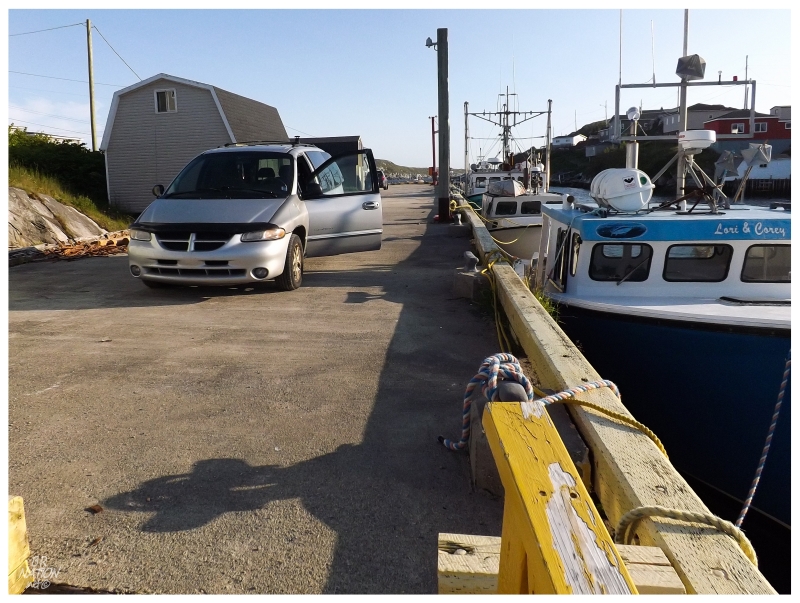
We made it three blocks from the house before the wheel clanged as we hit a pothole, the clearance simply not there in the van's wheelwell due to how much we were weighed down. There had also been worries about the brakes when the van was recently driven back from Nova Scotia, but we needed to get going and didn't want to unload the whole vehicle. This wasn't our vehicle though and I have to thank Rosie here. With surgical precision and a chessmaster's focus, she slowed down for shoddy Newfoundland bridges, manipulated curves for speed & potholes were gracefully maneuvered under the car but between the wheels. The wheelwell clangs would become rare and time started to pass at a slightly more relaxed pace. The secondary highway that would lead us to our boat was an additional worry, but soon enough we pulled down narrow roads and out onto the wharf. That was enough of that, we had made it & could worry about the ride back later. |
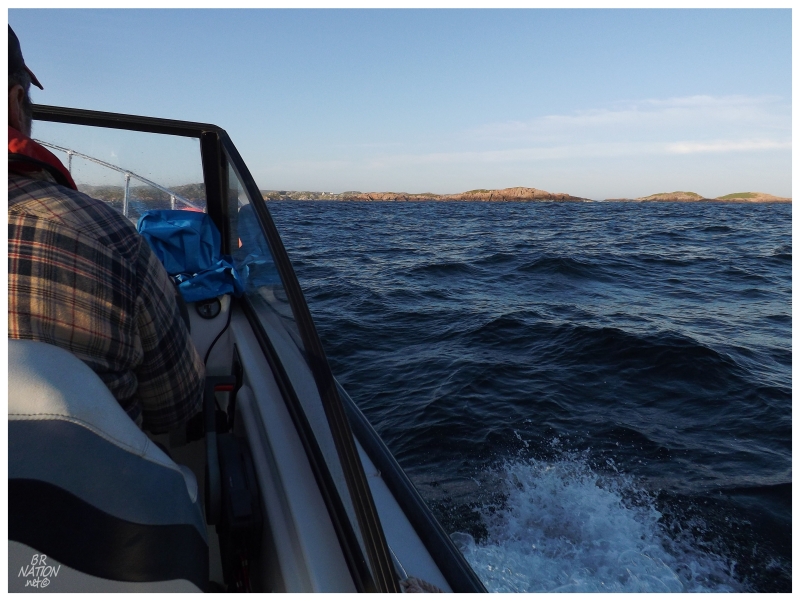
Back when I went out to this village in 2011, I didn't remember taking a very large boat. Would we have to take two trips today? A run of people, then another run of gear? Our captain laughed at how much gear we had, but didn't doubt for a second that we could fit it all in the boat. In addition to my amazement at everything fitting in the hidden compartments of the seemingly small vessel, it was also crazy how low the boat sat in the water with all of this weight. I'm typically used to going out to sea with only one or two other people, but here we were going remarkably slow and the water was right there, much of the hull beneath the surface of the water. |

Landing at our friend's dock, a few of us climbed up and formed a human chain to pass up our belongings onto the wide platform. Moving through the narrow alleys between the stages, we thanked our captain and made our way over to the school where we would sleep. Having to wait into the afternoon to leave home, we subsequently landed at the golden hour, with the village's church looking fine in glowing rays of the low, western sun. I don't remember making it back to the church before sunset in 2011, so I was amazed with the new development of this gorgeous view. The church was also looking a bit strange & only now looking back at 2011 pictures, do I see that it's because the steeple lost its railing sometime in the past 3 years. |

Back in 2011, Johan & I arrived late in the day & were overwhelmed with how much there was to explore before being picked up the next morning. With my 2014 group planning to spend 3 nights here, there wasn't the same rush or exhaustion from rushing about before sundown. This visit I had the time to casually take in the sunset by climbing a nearby hill. |
2011:

2014:
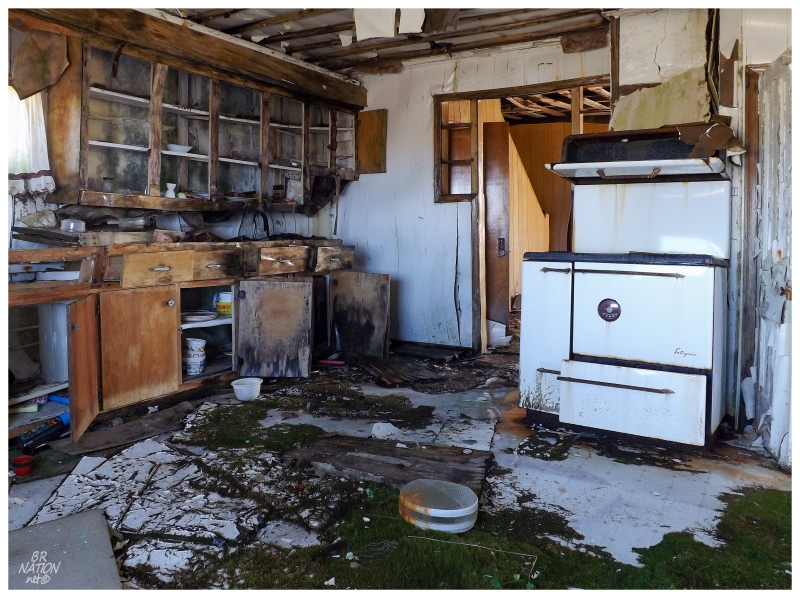
The next morning, refreshing my mind with the places I had seen 3 years earlier, one of the first things I noticed was how little had changed. While there were some houses I walked into and barely remembered them, the ones where I included pictures in my 2011 update were the ones where I stood there and couldn't pick out any noticeable differences. |
2011:

2014:

Across the harbour, I smiled at the preservation of this bookshelf. In addition to the lack of natural decay, it seems like hooliganism is lacking here as well. |
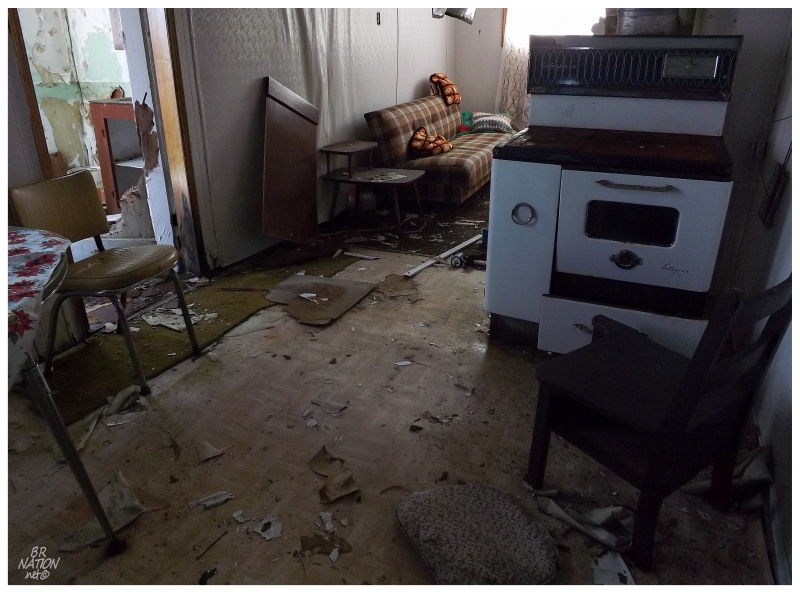
Not all of the houses were unchanged though, as natural decay showed in some homes through peeling wallpaper, greater carpets of moss & old mementos now laying on the ground. (You can see the above couch in 2011, with the wallpaper not as rippled.) I suppose my surprise comes from the fact that I thought Mother Nature would be winning to a greater extent over these last 3 years. It had been a five or ten years since resettlement when I first came here, thinking that was about the cap on the amount of years to see a place like this in passable condition. If 3 years only did this 'small' amount of damage, then the window is bigger than I thought. Then again, every additional 3 year period provides another prime window for a boatload of firebugs or vandals to discover this place. Admittedly, I'm also not helping anything by letting my vanity get in the way & posting this on the internet. |

Sadly, the one place where I was shocked by the greatest amount of decay was the town church. |
2011

2014
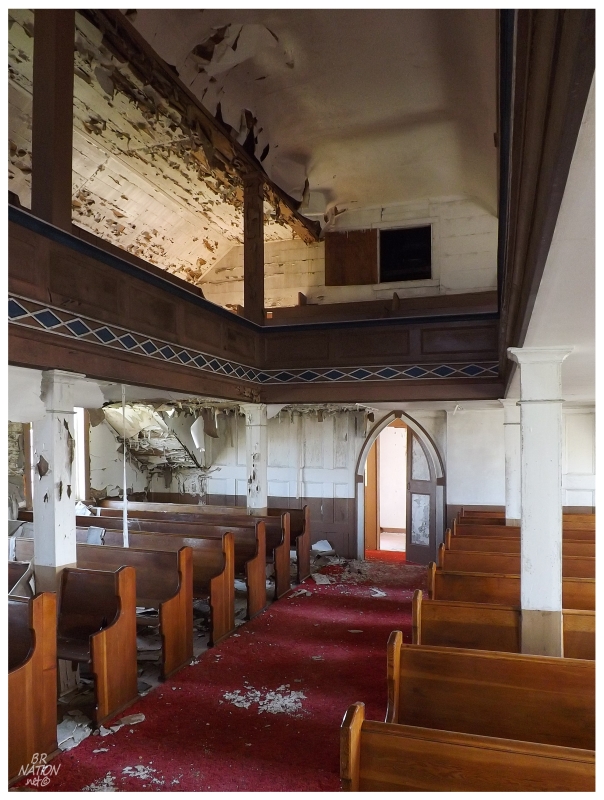
The southern pews were now saddled with plaster, the roof above failing from the front to the back. Where in 2011 there were enough problems to make me have to convince Johan to stay in here, the sanctuary nowadays felt abandoned instead of simply disused. This is one of the oldest churches in Newfoundland & there was initially talk of moving it to the highway network, but with those plans dissolving and the building now decaying to this extent, the odds are growing slim towards anything besides decay or demolition. (I say demolition because some people are of the mind that things should be demolished so that they don't have to look at them in a state of decay.) |

The church and a few houses would be home to the greatest amount of decay to my untrained eye. Thankfully, there was nothing that had experienced a catastrophic collapse, fire or takedown. One thing I noticed was that one of the houses at the northern back of the main harbour, had developed a crack where rooms had been added onto the house. Peering into the crack, you could see nails separated from where they used to sit, the back end of the house slowly falling away from the front. There's one house up by the school where the back is already collapsed like this & now it makes much more sense. |

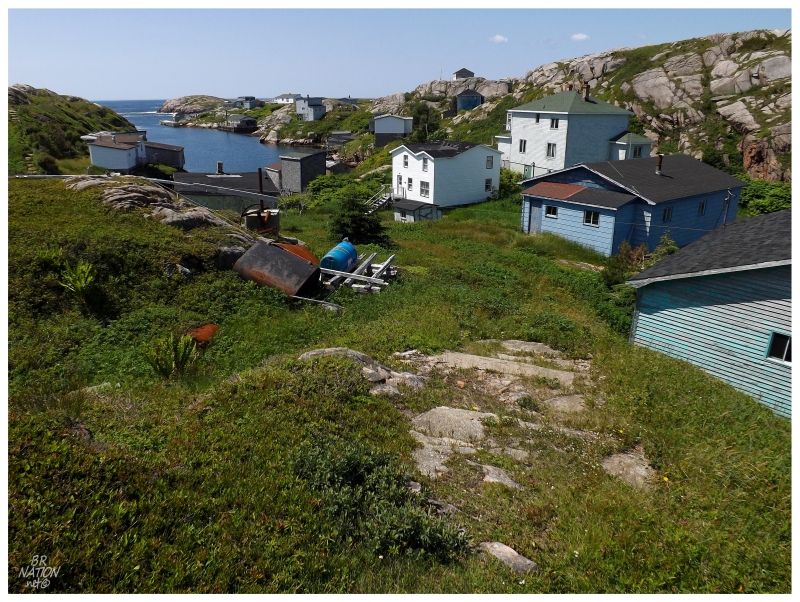
There were also about 5 houses that I couldn't revisit because they now had their locks replaced or engaged. Back in 2011, it seemed like all of the open places were forgotten and there was no end in sight to their death spiral - but, it looks like someone came along and secured their family's homes. |

Rounding the back of the harbour, I discovered one thing which was secured less than in 2011. That is the old store and post office. The left side would have led you to picking up mail and hearing a nice distant voice from this remote outport, while the right side would have provided you with ingredients to add to the food you grew in your garden or hunted and trapped here. |
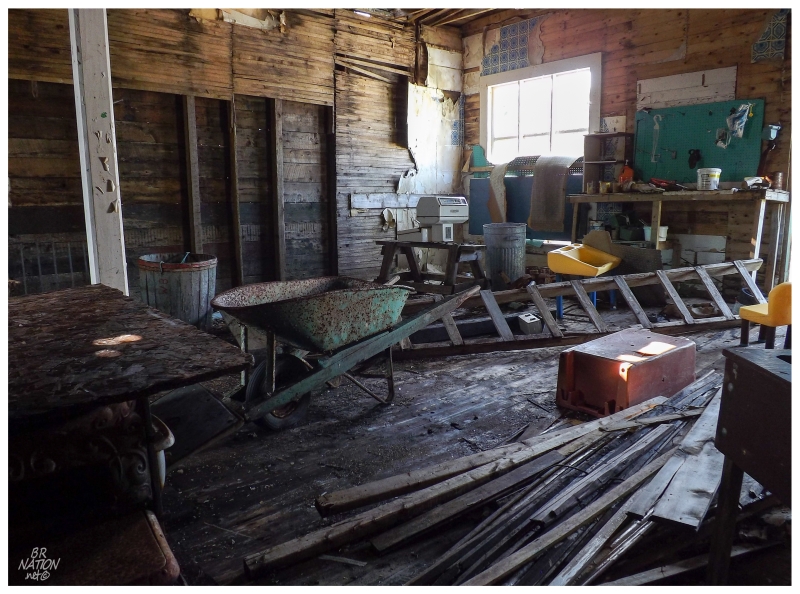
The store side. The much bigger room of the unequally divided building. |
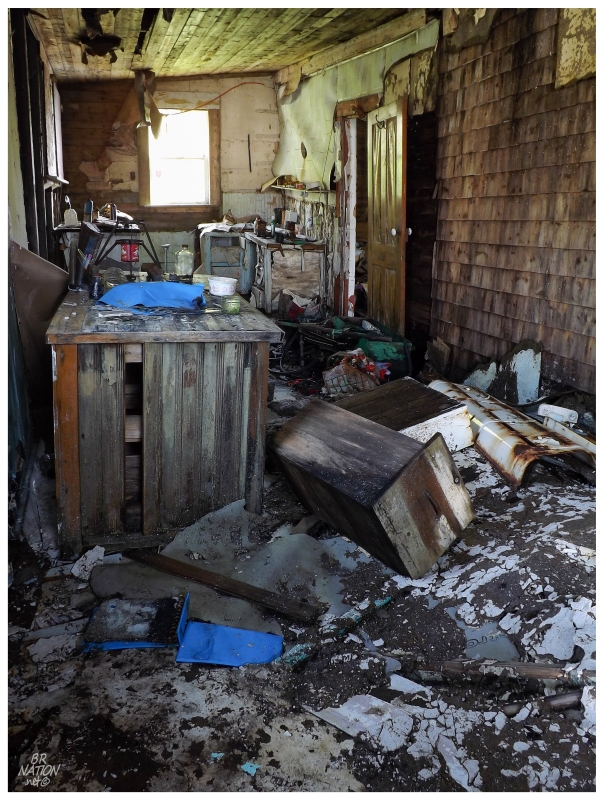
And the post office side. I closed the doors back up upon leaving & I think the ramshackle front stairs will deter most people. Then again, the safety this building gains from being elevated, it also faces contradictory, additional challenges because of how it is built upon stilts in the harbour. |
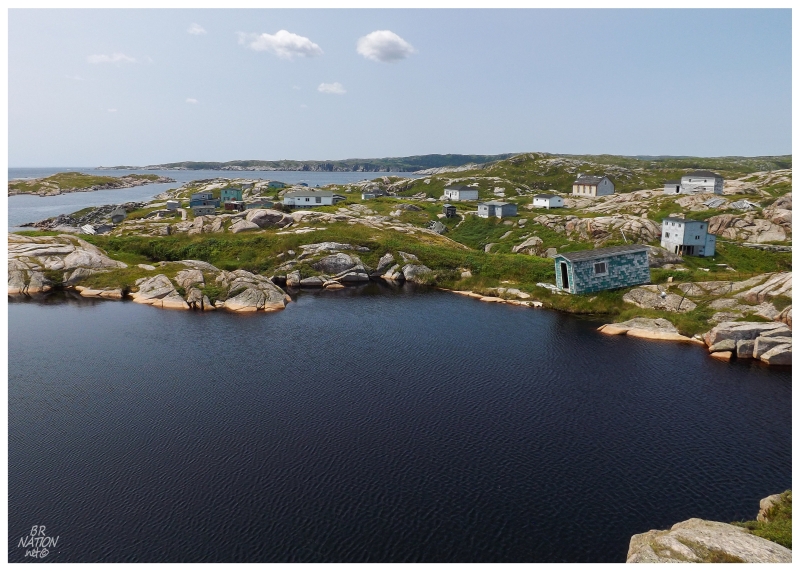
The store/post office is to the south of the two small hills which parallel the village's harbour. Instead of continuing on the concrete path to the southern group of 4 or 5 houses, I decided to round the hill and come up over the top. Blessed with such a fine day, it was hard to make a wrong decision with how one spent their time. |
2011:
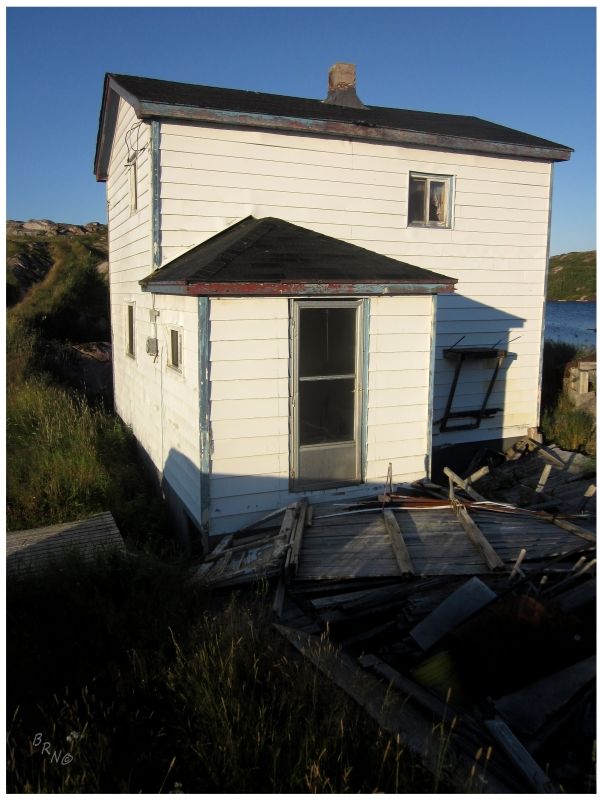
2014:

If you remember my 2011 update, then you'll remember that the eastern side of the harbour (with the 4 or 5 houses) was home to this house where I went to check the door, but then broke through a plank after finding the door locked. Making my way over to see if this house was going to give me trouble again, and subsequently to see if it was still locked, I instead found that someone scavenged the entire front door - meaning that all I had to do was carefully step on the soft, friable wood and pull myself inside. The amount of wood & debris meant that this still wasn't the easiest task. |

Inside I found that one of the last children in this town dreamed of hunky Californian rollerbladers. "Ohhhh why can't ripped shirtless dudes skate down our concrete pathways!" :) (I don't mean to make light of the situation, but I can't help how that rollerblader looks like he could be skating in this village instead of some park in California.) |
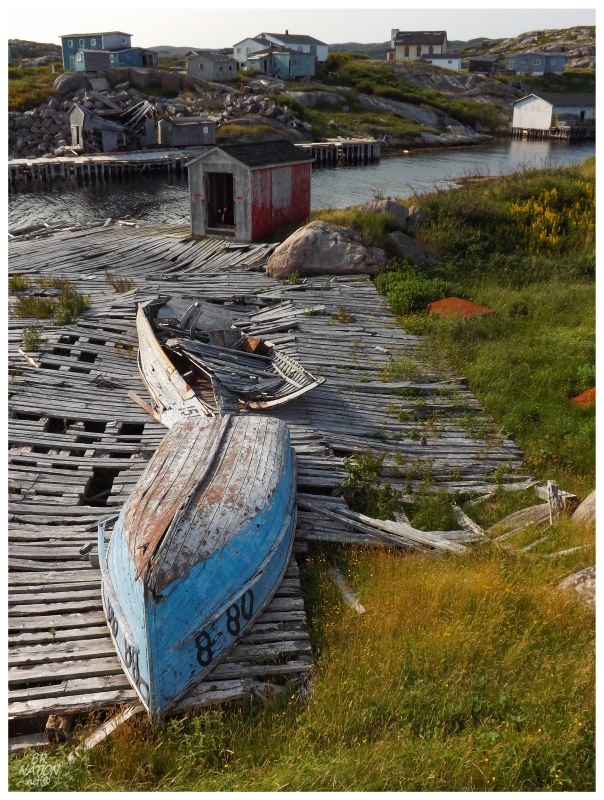
Moving along, this is the view out over the harbour from one of the other upstairs rooms. You would not miss very many boats coming into shore from up here. This is interesting because downstairs there was a logbook of cod catches, weights and fishermen. There is also the "police station" marked on the topographic map over in this area as well. All of this is enough to make one wonder if this house was home to the jack of all trades. I should have asked our boat captain instead of leaving you without an answer. |
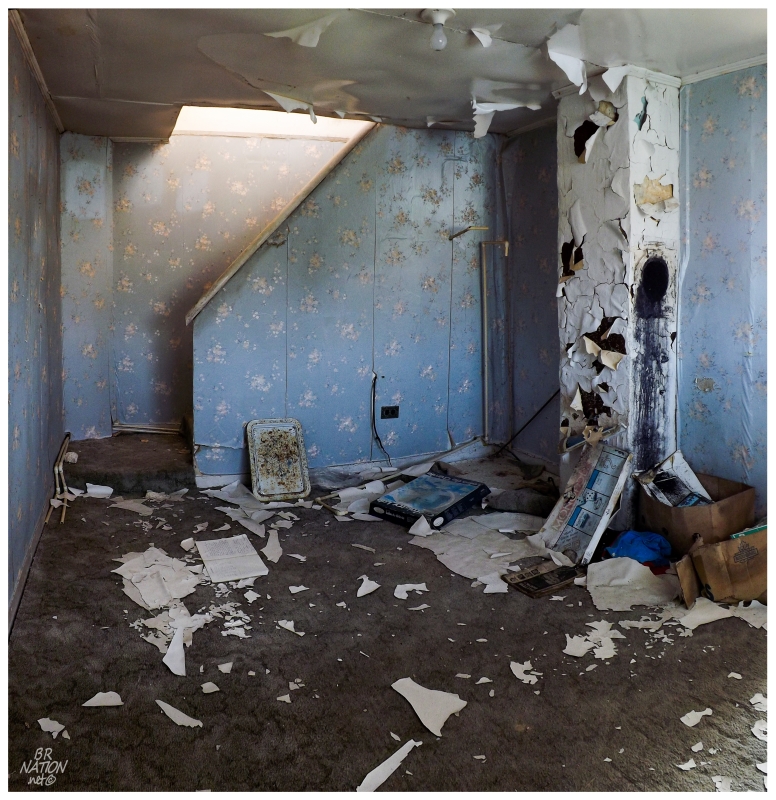
Downstairs. This was the only house that was new to me so I ended up spending more time there than you normally would. I don't think anyone else in the group even bothered with climbing atop the dangerous, nail-ridden woodpile to pull themselves inside. |
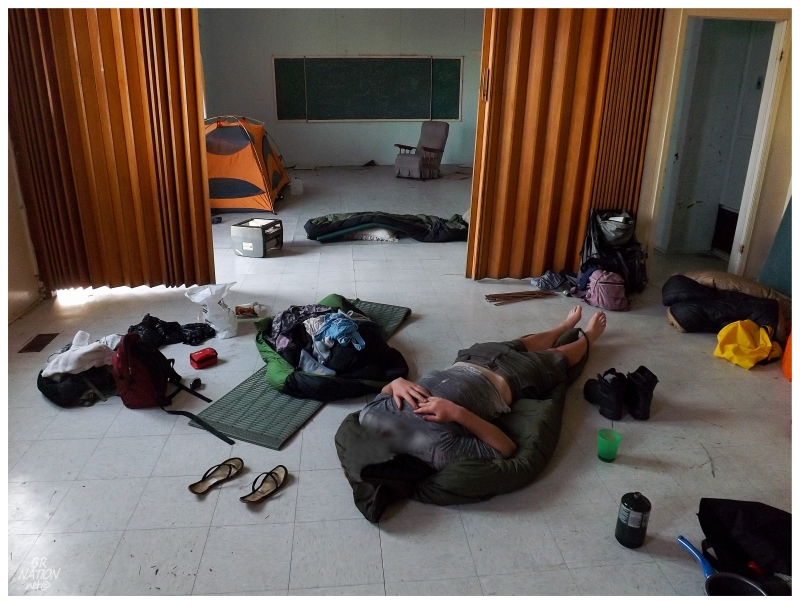
Back at the schoolhouse, it seemed that I walked in on Christian's siesta. As to what the rest of the group - all of whom aren't so obsessed with documenting old, terminal buildings - got up to throughout the day, I know there was some reading, relaxation and exploring on their part. They even had some visitors as a large family showed up to show their children where they grew up, pointing out their old homes and reminiscing about going to school in our temporary sleeping quarters. One of the good things was that they said we went swimming in the village's water supply pond. This was weird for them as they grew up respecting and staying out of that water, but they were happy we didn't choose the other pond. Apparently the other pond is where some residents used to dump old machinery. |

Once it was back to the just the six of us again, I actually napped for a bit with all the time afforded me here. Waking up in the soft summer evening, I was now on my fourth run through the village and I tried to pick out some of the places I might've paid little attention to in the past. Case in point the above home, which was gutted inside, but nice enough for an exterior photo. Now that I was here in this village for my second time, I felt joy in that I was starting to cover some of these smaller homes. Like this house for instance, which could mean the world to someone who happens upon this webpage. Not every strongest memory is made at the town's most opulent house or the church. |
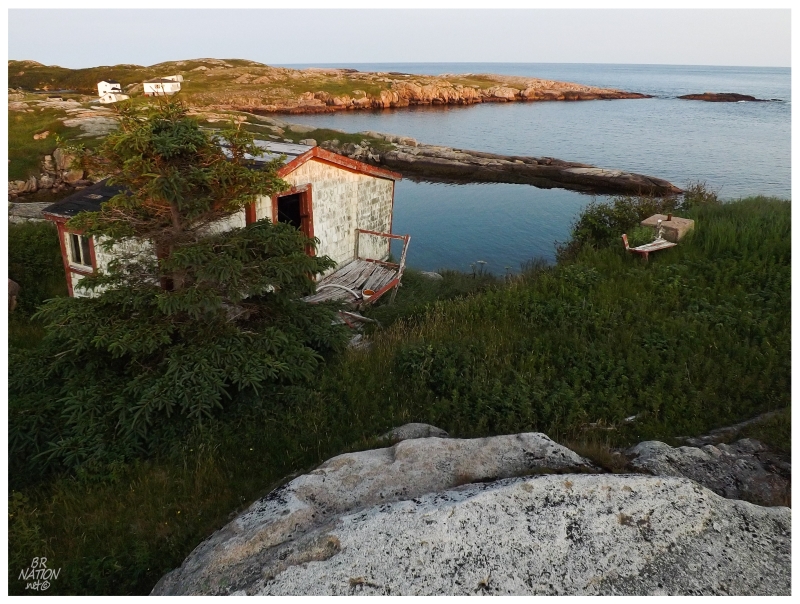
I also popped into a few more sheds, taking advantage of the ones still hanging on enough to explore. |

The majority of them looked like this on the interior, where I'm sure scavengers rummaged through everything long ago. Regardless of there being any valuables left, these little sheds also contribute to the feel of a Newfoundland community, so I was more than happy to pay them some attention. |

I wore myself out before long and the perfect day eased into a fine night. The lack of clouds to procure a crazy sunset, and the desire to take it easy with friends and enjoy dinner, meant that I didn't rush off towards anywhere for the last minutes of daylight (as I so often do on these excursions). |

We sat on the back bridge of the schoolhouse and chatted in the warm summer's night, enjoying each other's company and this little slice of Newfoundland that was ours tonight. |
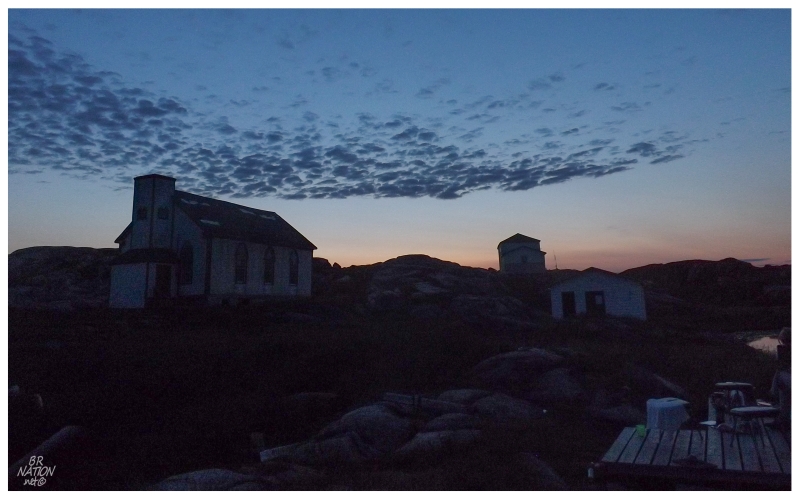
And even into the morning hours. Something was clearly clouding my judgment though, because after putting in the effort to be up for sunrise, I didn't use a tripod. Sigh. (And that's without saying anything about how bad that night photo is!) |
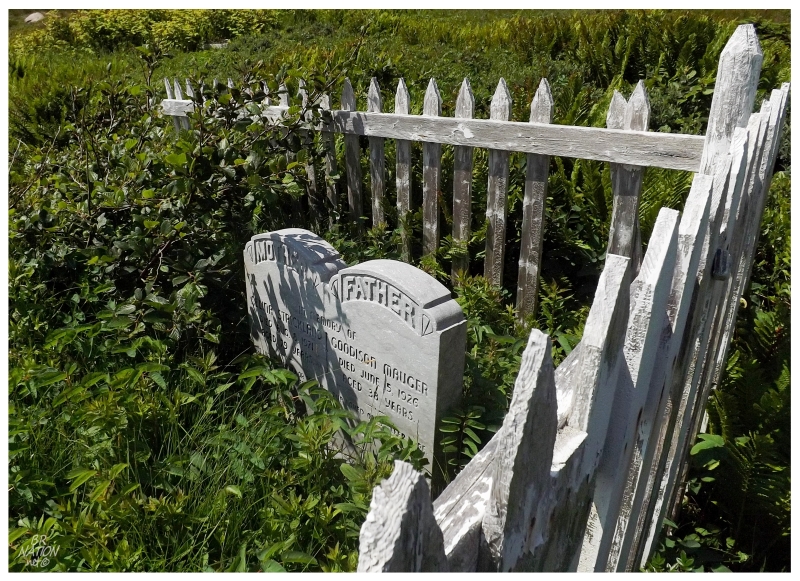
The next afternoon, I eventually got moving because I didn't want to miss the cemetery again. Where I didn't know its location when I was here with Johan, I didn't even think about the village having a cemetery since you don't come across it by walking through town. It was only once I got back and looked at a topographic map of this place, that I noticed the cemetery symbol off to the east, in the flats to the other side of one of the village's main hills. |

In a province where you almost get used to seeing child, teen & young adult graves, this one stood out: "In Loving Memory Of Norman (Aged 27 Years), Clayton (Aged 25 Years), Frederick (Aged 21 Years). Beloved sons of James & Florence Courtney, who were drowned Jan 22, 1935." That is some amount of loss & grief. |
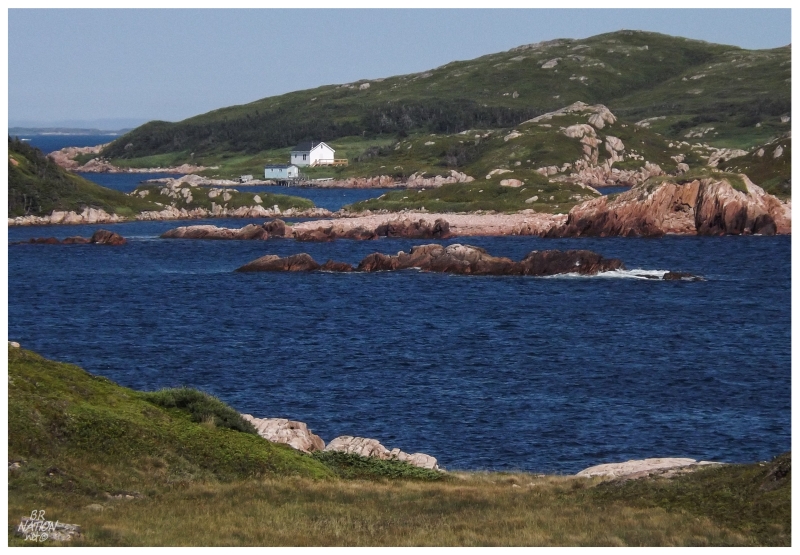
After looking around the cemetery, I wanted to follow the coast to the east and explore the empty barrens outside of the village. I also knew that not too many people had found themselves out this way, which is why it held additional appeal. Lo and behold, what seemed like a trail led to a toppled sign for a trail that must've existed when this place was still settled. Roughly following it and appreciating a few pallet bridges over small creeks, I eventually dipped down to the ocean for a swim that was far too cold. I then continued further to the east, seeing a couple of cabins far ahead. My initial pictures at 24x zoom were extremely hazy, so I was more than happy to keep walking along and get a better view. The above view is about as close as I got before deciding to turn around at the sight of a big canyon & the annoyance of flies. It's only right now looking at Google Earth that I realize the cabins were on a tiny island in front of that bigger back island. And here I thought they were all on that back island! How neat. |

^A pair of Spruce Grouses that shot up from behind a ridge on the way back. Returning to the school, we were all happy that our boat captain was nowhere to be found because there was a chance he could be coming for us this afternoon, but that he would think about leaving us for another day. As this update is nearing its end, I imagine you can guess what happened next. Noticing a familiar boat coming into the harbour, we started hurriedly gathering what we had left. Another night would have been fantastic, but we had to be happy with what had been such a successful trip. |

Pulling away from the village and wondering - like I did in 2011 - if I'd ever be here again, I was happy that my mind suddenly switched to the memory of quarried granite. At the turn of the 20th century, future St. John's mayor William J. Ellis owned a quarry here, employing local fisherman in the harvesting of granite. What's special here is that the granite's most important contribution is being part of the very impressive St. John's Courthouse. Ellis would greatly benefit from the fact that a Nova Scotian won the contract for building the courthouse, because it was only after public outcry that the Nova Scotian changed his plans from importing materials from Nova Scotia, to using "stone from the quarries, whinstone from Kelly's Island, brick from Trinity factories and lumber from the Horwood Lumber Co." As we passed by the last shores of the harbour, some of the quarried rock still lay in waste/discard piles here, narrowly avoiding a much busier life in the big city.
Anyway, returning to the highway network & thanking our ship captain, the six of us would drive down the road and camp at a nearby abandoned building that I knew about, with half of us staying up and enjoying ourselves for one last night. Also of note, this was the first time I camped with only a thermarest and a sleeping bag (no tent); myself grateful for the lack of spiders & scorpions in Newfoundland. Speaking of drinking one last night, the van no longer knocked against the wheelwell and there was amusement that the reduction in adult liquids was seemingly the cause. Although I'm sure food and water consumption may have played a role as well. Conclusion My 2011 trip left me with a desire to return to the village in the 2030s or 2040s, but now that I've been back and seen this village change over a 3-year period, the desire to return in the future is even greater. We'll have to see what the future holds and how far or close I find myself to this village later in life. |
